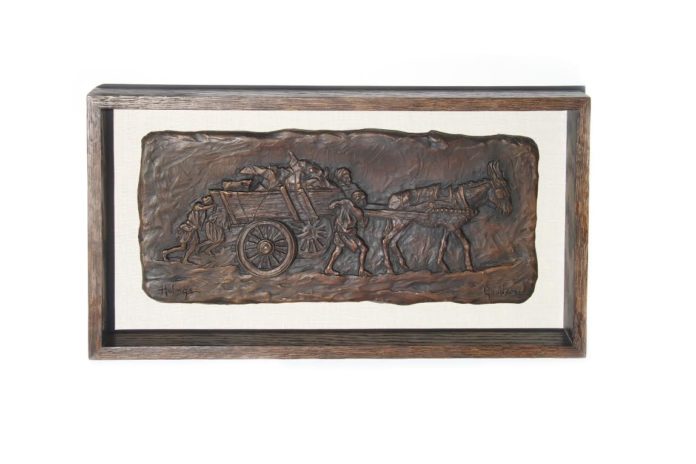The Clark Hulings Fund for Visual Artists (CHF) recently announced a unique artistic and philanthropic collaboration with master sculptor Glenna Goodacre. Collectors and major donors should look at this opportunity. What is it? Find out here!
What a way to head into retirement. In collaboration with the Clark Hulings Fund for Visual Artists (CHF), master sculptor Glenna Goodacre — a longtime friend of the late Clark Hulings — will produce a series of bas-relief sculptures inspired by the iconic Hulings drawing “Helping to Push.” However, the story doesn’t stop here. The CHF will then produce a limited edition of 25 bronzes, and will gift them as a thank you to major donors to the fund.
According to the non-profit organization, Goodacre’s decision to re-interpret “Helping to Push” was no coincidence. They write, “When Elizabeth and Mary Hulings first founded CHF, this particular piece was the fund’s iconic image because its title and subject captured both the essence of the nonprofit organization — to help artists who are helping themselves — and its namesake’s view on life. ‘My father was always interested in images of people working together, and with their animals,’ said Elizabeth Hulings. ‘He had a great passion for collaborating with peers. He wasn’t a teacher, but he still wanted to help other artists — which is the reason we started CHF.’”
Continuing, the CHF says, “As the CEO of her own corporation, which she established in 1979, Goodacre understands firsthand how important it is for artists to have the knowledge and tools to run economically viable businesses. The internationally renowned sculptor has had a long and illustrious career, creating more than 600 works, of which her most famous are her Vietnam Women’s Memorial in Washington, DC, the massive Irish Memorial in Philadelphia, and the Sacagawea U.S. dollar coin.
“The bas-relief, which carries both artists’ signatures, offers a vibrant interpretation of Hulings’ drawing, capturing the original’s sense of movement. ‘It’s a phenomenal piece she’s created, with great textures and lines that are strongly reminiscent of the drawing, and of my father’s technique with pen and ink,’ said Elizabeth. ‘The quality is extraordinary, which would be surprising, except that it’s Glenna, and we all expect that level of work from her.’
“The framed piece will be offered as a thank you gift on a first-come, first-served basis to those who contribute $15,000 or more to CHF. Donations to the fund are tax deductible, excluding the amount of goods or services received, which in this case will be $5,000. The fund plans to offer only this one limited edition of the work.
“Goodacre’s corporation will be dissolved at the end of this year, and she is no longer creating new work. In advance of her retirement, she is destroying her molds for existing sculptures, and selling or donating tools and artwork from her private collection. One of her most recent gifts was a bronze entitled ‘CEO,’ her homage to female business leaders; the sculpture depicts a businesswoman on the move, and Goodacre’s daughter — Jill Goodacre Connick — served as the model for the piece.”
To learn more, visit The Clark Hulings Fund for Visual Artists.
This article was featured in Fine Art Today, a weekly e-newsletter from Fine Art Connoisseur magazine. To start receiving Fine Art Today for free, click here.








